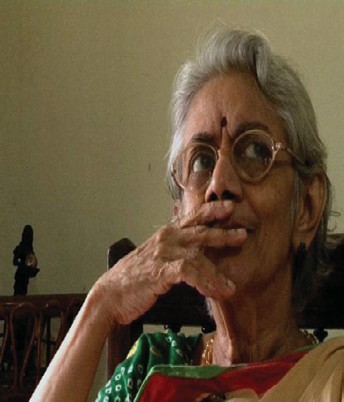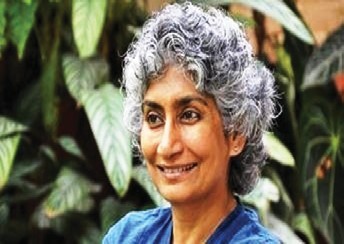 Historian and film maker Uma Chakravarti
Historian and film maker Uma Chakravarti
Ye Lo Bayaan Hamaare (2021) is the intriguing name of a long documentary film directed jointly by Uma Chakravarti and Priyanka Chhabria. It was one of the biggest crowd-pullers at the recently concluded 8 th Kolkata People’s Film Festival in Kolkata. The Festival is organised by the People’s Film Collective, a people-supported, independent, volunteer-led festival that showcases politically committed contemporary documentary and fiction films from India and South Asia.
Uma Chakravarti is an Indian historian, academic and filmmaker, who has written extensively on Indian history involved with issues relating to gender, caste, and class. She stepped into the rather rough and challenging terrain of cinema after she retired from teaching. She has also made documentary films on women’s history. Among them are Prison Diaries, A Quiet Little Entry, Darbar-e-Watan and Fragments of a Past – Lucknow, 1920 – 1949
Ye Lo Bayaan Hamaare can be called as an extended sequel of Prison Diaries, another brilliant film. Prison Diaries takes us on a journey into the past to offer us a close glimpse into the life, and death of the late Snehalata Reddy who was arrested soon after the Congress Government led by Indira Gandhi declared Emergency on June 25, 1975. Snehalata, who began her career as an actress, director who brought a kind of revolution on the Kannada stage and also in her films, kept a
 Nandini Reddy daughter of Snehlata Reddy
Nandini Reddy daughter of Snehlata Reddy
diary when she was in prison and Chakravarti names the film after this diary. The stress of the film is on how the Emergency saga had its share of women heroes who stood up for what they believed was right. Snehalata Reddy was one of them.
The Emergency suspended all fundamental rights and imposed strict censorship on all channels of the media. Mass arrests began on the night of 25 th June 1975. Resistance to the government and to the Emergency continued to gain momentum and so did the arrests. There is a Black-and-White clip of Indira Gandhi and one can hear her voice proclaiming Emergency.
Chakravarti`s latest film, the 141-minute-long documentary, And We Were There – 1967-1977 was one of the biggest crowd-pullers at the festival. In Hindi, it is called Yeh Lo Bayaan Hamaare. In her own words, “This is a film about idealism, passion and jail time of young women coming of age in the late 1960s, seeking to change the world and throwing them into the rebellious movements sweeping parts of India like Bengal, Bihar, Delhi, Bombay, Hyderabad and Bangalore.”
Chakravarti zeroes in on the first-person nostalgic experiences of 15 such women, some of who are no longer with us, who surrendered themselves, leaving home and hearth, to get sucked into the movement even when, towards the end, some of them realised that the movement is doomed to fail.
They mainly speak of their prison experiences where they were tortured almost to the point of death by the police and not given the constitutional right political prisoners are entitled to. The interviews began in 2010 and went on almost till 2020 and the film spans the period 1967 – 1977 passing through India Gandhi’s declaration of the Emergency in 1975 and closing with the end of Emergency in 1977 with the declaration of the General Elections.
These women surprisingly, instead of harping on the inhuman torture they had to undergo never mind their age, gender, health conditions and marital status, harp on the beautiful “alternative world” they discovered within those iron bars of the jails where other women prisoners caught for theft and other minor crimes gave them solace when death is the only wish they
had left.
Rajshri Dasgupta who is now a noted women activist and journalist, narrates an incident when, on a night after day-long torture in a special room created for torture, she was brought back to her cell, another inmate she does not even know the name of, placed Rajshri’s head on her lap and patted her to sleep after giving her sips of water. “Till this day, I have no clue who this woman was, what her crime was and what her name is. But her putting me to sleep gave me the moral and physical strength to face the torture waiting for me the next morning.” According to Uma Chakravarti, Rajshri had repeatedly said “no”
to facing the camera. But when two other women namely (late) Meenakshi Sen and Krishna Bandopadhyay were being interviewed, she came forward on her own and began to speak.
The film, besides being filled with interviews with (late) Sreelatha Swaminathan, Deepa Dhanraj (filmmaker who was very young then), Jaya Mitra, Jhelum Varde, Vasanthi Raman, K. Lalitha, Vina Shatrughna, Swarna A.P., Ambika, Lalitha, Vina Shatrughna, Swarna A.P., Ambika, Mrinal Gore, Ahlya Rangnekar, also very young then, and Maya Devi from an Adivasi group who says that she joined the underground movement following her daughter when the girl was 14 and she has no regrets about her daughter being killed when she was barely 22 because, “Every dream and every movement charges a price so I consider that my daughter’s life was the price.” The film also uses clips of films like Do Bigha Zamin to focus on the exploited farmers to give justice to whom the movement took birth and flourished, Sukhdev’s satiric comedy Maa Ki Pukar, and some clips from Anand Patwardhan’s Prisoners of Conscience (1978) also from I.S. Johar’s satiric film Nasbandi on Sanjay Gandhi’s forced vasectomy programme which possibly led to the Emergency preceded by the collapse of the then-Congress-ruled government.
The film opens with clips from a beautiful song sequence from Bimal Roy’s film Bandini (1963) showing a prisoner singing “Ab ke baras bhejo bhaiya” recalling her sweet memories of her brother back home as she grinds wheat on a hand-spun grinder and looks out wistfully and birds homing back too their nests on a bare tree. The lines of this song get repeated at different points of the film driving home the issue of life for any woman behind the bars of a prison cell.
Minakshi Sen, Jaya Mitra’s cell-mate, speaks extensively about “Pagolbari” in her book Jailer Bhitor Jail (Jail Within the Jail, 2014) while Mitra explains the sheer irony of the term “safe custody” in her memoirs, Hanyaman. Both Mitra and Sen do appear in the narratives but only as inquisitive voices who coax out the life stories out of their fellow inmates. Uma’s film however, does not make any mention of these books written by some of the women prisoners who have written at length on
 Film maker Deepa Dhanraj
Film maker Deepa Dhanraj
their radical activism for the CPI(ML) and also, about their experiences within the prison bars.
The film is intercut with newspaper clippings at every turn that mention Indira Gandhi’s declaration of the Emergency in 1975, following which George Fernandes had to go into hiding, beginning with the 1966 Food Movement in Bengal, and many similar news stories that add to the background history of the Naxalite uprising, a very virulent movement that failed, according to the women interviewed, due to the wrong strategy of its leaders.
Krishna Bandopadhyay in her book writes: “So many women joined the movement, but on the party’s part there was no actual directive as to what their role was expected to be. Many commented that even in the case of the men, there were no specific directives. For the sake of argument this is perfectly true, but the party leadership was male and can it be denied that their policies would automatically tend to be patriarchal?”
But you look at them today, and they maintain complete silence on their involvement in the very radical movement that shook the country in general and West Bengal in particular for a few years. This writer has personally known some of these women in different degrees of proximity but it is only through Uma’s film that she discovered the scary history of these women and their sacrifice attained for an illusory future that took along with it, hundreds of lives of talented and brilliant young students who got involved in the movement.
The filmmaking itself is mind-blowing the way it juxtaposes interviews with voice-overs, newspaper clips, video clips and soulful music. It offers a glimpse into the character of the print media in those days, certainly factual and narrating the
truth.
A beautiful film indeed; one for the archives and for students and researchers on the political history about a period that many Indians do not know.
Shoma A. Chatterji

